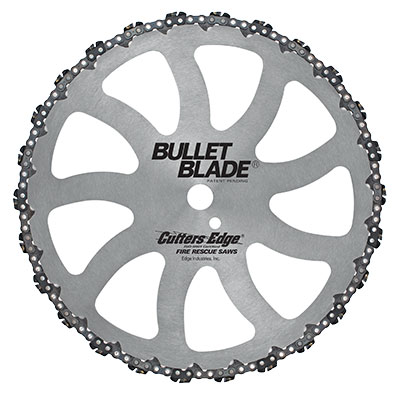
Equipment
Techsmart: Bullet Proof
As new technologies continuously arise, some things in the fire service have remained essentially the same. The saw is one of those things.
September 10, 2013
By Olivia D’Orazio
As new technologies continuously arise, some things in the fire service have remained essentially the same. The saw is one of those things.
 |
|
| The Cutters Edge’s Bullet Blade saw features the speed of a rotary saw and the resilience of a bullet chain. Photo courtesy Cutters Edge.
|
For example, chainsaws are almost always used during ventilation operations to cut through housing materials – wood, stucco, plaster, nails, roofing paper. Rotary saws, meanwhile, are used for heavier materials, such as metal doors during forcible-entry operations.
There’s solid reasoning behind this; the chainsaw is long and can cut deep into thicker materials, such as those found on a roof. A rotary saw, however, has the speed and the power to cut through strong metal objects, such as heavy-duty doors.
Now, Cutters Edge – the developer of the bullet chain, which is manufactured specifically for the fire service – has produced a rotary saw that uses a bullet chain. The Bullet Blade features the speed of a rotary saw and the resilience of a bullet chain.
Cutters Edge president Thomas Ruzich, explains: “Right now, many fire departments will carry both a rescue chainsaw, for cutting materials like wood, stucco, plaster, nails and roofing paper, and a rotary saw, which will cut virtually
any material.
“The chainsaw can cut vehicle materials, but you’ll have catastrophic failure – you know you’re going to damage the chain. The Bullet Blade, because it’s moving three times faster than the chainsaw, can cut the materials that [would normally] break the chain.”
It’s a simple law of physics, Ruzich says: velocity will always overcome mass.
Andrew Brassard, a forcible-entry instructor and firefighter with the Milton Fire Department in Ontario, says he could see his team using the Bullet Blade on older-style buildings.
“For ventilation on a flat roof, primarily those in downtown cores, for example, I think it would be fantastic,” he says.
Because the chain on the Bullet Blade is running at 100.6 metres per second (330 feet per second), on average, it’s able to cut through things such as a 3/8-inch-thick steel plate, any building material, concrete blocks, rollup doors, garage doors, and large vehicles – semi trailers, trains, buses, and even aircraft.
“After my 30 years in the fire service, I’ve been trying to find the best tool for cutting into aircraft,” says Ruzich, who is based in Oregon. “Everything behind this was trying to find a tool that worked well on aircraft, that we could use on the crash rescue field. The Bullet Blade can cut through all those materials on the aircraft.”
The Bullet Blade has been in development for several years. Ruzich says he and his team worked to get the chain onto the blade securely. With older rotary saws, when the blade dulls or enough of the picks break off, typically you dispose of the entire blade. With the Bullet Blade, the core of the blade can be reused; the chain is removable and can be taken off and sharpened or repaired, if necessary.
“Up front, it’s a bit more expensive,” Ruzich admits. “But over the life of the blade, it provides cost savings.
“In most cases, you’d only need to sharpen the chain; it’s very, very rare that it would break. That extra speed reduces the breakage so dramatically.”
The shape of the chain also protects the saw, further extending its life. The cutting edge of the saw is protected by the design of the bullet chain. The saw takes smaller bites out of the material being cut than a traditional chainsaw would, but it has a wider cutting ability: only the tip of a chainsaw actually cuts into the material, but a rotary saw offers 180 degrees of cutting activity. So, even with 70 per cent of the picks dulled or broken off, the Bullet Blade can still function.
“We didn’t design it to never break, because that’s impossible,” Ruzich says. “We designed it to break off strategically.”
Because of the Bullet Blade’s composition and ability to withstand moderate damage, firefighters can completely finish difficult cuts without having to switch tools, change a blade, or experience complete failure of the tool.
“The bullet chain is not new – it has been in the fire rescue industry for 25 years,” Ruzich says.
“It has served us well for one configuration; we’ve just expanded its usefulness to us.”
For more information on the Bullet Blade, visit www.cuttersedge.com.
Print this page